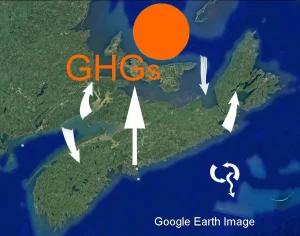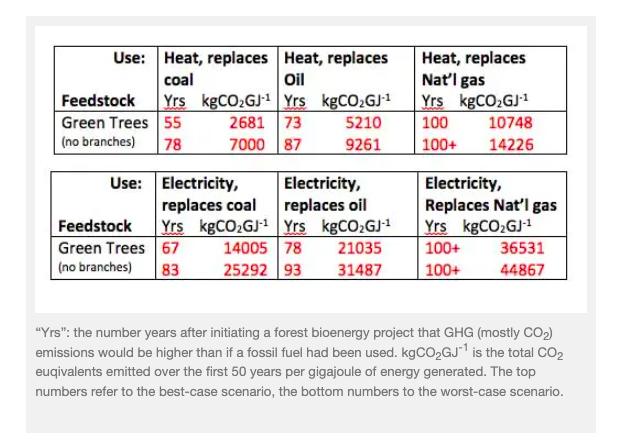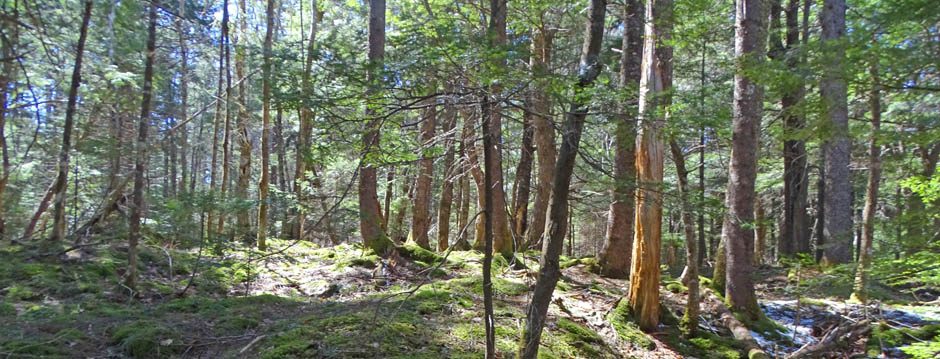Page Posted Jan 21, 2023

Curved arrows represent biologically mediated flows of GHGs: the straight arrow, industrial emissions of GHGs; and the symbols at bottom right, long term sequestration of carbon in the oceans. Carbon dioxide is the most important GHG in relation to forestry.
“New paper out on life cycle #GHG dynamics for different scenarios of forest-based bioenergy in Nova Scotia”
So reads an Announcement on Twitter by James Steenberg, first author of the paper, on Jan 2, 2023.
The tweet provides a link to: Life-Cycle Greenhouse Gas Emissions from Forest Bioenergy Production at Combined Heat and Power Projects in Nova Scotia, Canada, by James W N Steenberg, Jérôme Laganière, Nathan W Ayer, Peter N Duinker, published in Forest Science Jan 2, 2023.
Comment. The full paper is not publicly available on the publisher’s site. I learned about it from a Facebook Post on Jan 20, 2023 in which a PDF of the paper was also provided. I was asked to comment on the FB page. Here is what I said after a quick look at the paper:
Thanks for highlighting this one B.W. ‘Curious how C.N. came across it. NRR News Release? (Unlikely, but who knows.)
Steenberg is the “carbon modeller” DNR/L&F hired in 2018 (NSFNm Aug 14, 2018). He had been at Dal a number of years as a postdoc etc working with Prof. Peter Duinker, mostly on urban trees. He was lead author for “Exploring adaptation to climate change in the forests of central Nova Scotia, Canada” 2011 with Duinker and Peter Bush as co-authors. (Bush who is also at NRR, had also spent time with Prof Duinker at SRES).
Anyway, I am glad to see the paper, I have advocated for this type of analyses repeatedly on NS Forest Notes. On a brief read it appears well done, meets the publication standards of today etc. So that’s good , that at least some DNR/L&F/NRR research folks are submitting papers for peer review.
Sketch shows prominence of low BS% forest soils in Nova Scotia. After Keys et al. (2016), Fig 3.
One concern: they end by trying to put a favourable light on biomass, rather than expressing caution about its application in NS, in particular related to the very poor nutrient status of circa 60% of forest soils; there is reference to soil nutrients but it could be much more specific and cite the work of Kevin Keys at NRR.
Also, what happens to it all in the more public domain? Where/when does NRR start to discuss these issues, the implications etc publicly, and apply the precautionary principle to our forestry practices?… That could have been done years ago, re: [the availability of tool for estimating GHG balances as in] Natural Resources Canada GHG Calculator confirms Nova Scotia forest bioenergy schemes are worse than coal (Post on NS Forest Notes, Jan 3, 2017.
I added these further comments after I had read the paper in more detail:
Steenbery et al. have introduced what seems to be a new ploy in the obscurification of GHG balances: the “different market/supply-chain assumptions around additionality and product substitution”.
All additionality runs of the model for primary biomass (roundwood) have carbon parity times of 86 to 100 years. No surprise**
But the corresponding “Product Substitution”. also referred to as BAU (Business as Usual) scenarios, are 4-9 years. Basically the latter means that “oh gosh we lost the Northern Pulp operation, and this is a substitution for that industry that would have been emitting GHGs anyway.”
Wow. So if an industry goes down because of environmental concerns as this one did, re Boat Harbour, we still have the right to assume we can keep on polluting the same old way? (One could also ask… why didn’t Steenberg et al. also estimate the time to parity if that original industry reduced its GHG emissions in response to climate concerns etc… i.e., it’s a potential rabbit hole of counterfactual scenarios).
Likewise no surprise** on this: “Net GHG benefits were achieved in 10 years with the use of secondary biomass (mill residues) as the bioenergy feedstock, although they were delayed when at lower energy conversion efficiencies.”
So I do not see this paper as adding anything fundamentally new to our understanding of Forest Bioenergy in NS, but it does or could introduce a lot of confusion.
Read the first paragraph under Discussion, in particular the last sentence: “From an accounting perspective, it is also challenging to determine whether biomass harvests are additional or not in the context of evolving forest product markets and demand.”I am concerned that’s an “it’s all too complicated to make any firm conclusions” message.
I am also concerned about “Natural disturbance is another source of uncertainty”, that this can be used to justify using blowdown as bioenergy feedstocks (as opposed to leaving it in place or turning it into other long-lasting products).
Finally, there is no consideration or even mention of the export of wood chips or pellets from NS for bioenergy use in Europe, a major area of controversy- and obscurification on the part of Canada at the federal level but one that is losing ground.
** “Not surprising”: see Natural Resource’s Canada Bioenergy GHG calculator. It’s application to forest bioenergy is discussed in Natural Resources Canada GHG Calculator confirms Nova Scotia forest bioenergy schemes are worse than coal (Post on NS Forest Notes, Jan 3, 2017).
Steenberg and Co. used the same model, ‘came to basically the same conclusions as I did using the calculator.+
+At least in relation to additionality scenarios which are generally the major concern about larger forest bioenergy projects (they begin by or claim to be using only genuine wood-processing wastes but soon rely on/stimulate harvesting that would not otherwise occur). From Steenberg et al. 2023: “…carbon parity [for combined heat and power projects] was achieved in 86–100 years or longer when biomass harvests were additional”. From the the NSFN Post (Jan 3, 2017):

————————————–
Post-script: I would welcome and would post comments in response to this post from James Steenberg & Co./NRR.
-david p Jan 21, 2023.
Jan 23, 2023: A question that might be asked of the authors now ‘the numbers are in: ‘Based on the results of your paper, would you conclude that electricity generated by the NSP Port Hawkesbury Biomass Plant can be considered “renewable”? Is it contributing to a reduction of GHGs over a meaningful timeframe?
Some Related Items In the News over the past year
Jan 11, 2023:
Auditor general finds Prince Edward Island government not following own forestry management policies
By Stu Neatby SaltWire “…has not conducted audits to determine whether or not wood harvested for biomass is being harvested sustainably”
Dec 13, 2022:
Why burning primary woody biomass is worse than fossil fuels for climate
By Edward Robinson, Hannes Böttcher, Klaus Josef Hennenberg and Sampo Soimakallio on www.euractiv.com/ Also see RED III greenhouse gas balance methodology: an important element of the IPCC rules is missing and related scientific paper
Dec 2, 2022:
– More than 70 EU signatories call for efficient, circular use of woody biomass residues
By Bioenergy Europe in Canadian Biomass “… the signatories renewed their concerns that the European Parliament’s proposal for a new definition of “primary woody biomass” in REDIII would prevent the efficient and circular use of woody biomass residues, and put EU energy security at risk. Bioenergy and, in particular, woody biomass are Europe’s most prominent local and sustainable energy source, it represents 10 per cent of the total energy we consume, with over 96 per cent of biomass produced domestically…they point out that the definition currently proposed by the European Parliament does not reflect the reality of sustainable forest management and bioenergy.” See the Full Signatory Statement
The signatories are concerned about the proposed European directive “‘Biofuels, bioliquids and biomass fuels produced from forest biomass….shall not be derived from primary woody biomass“, where ” ‘primary woody biomass’ means all roundwood felled or otherwise harvested and removed. It comprises all wood obtained from removals, i.e., the quantities removed from forests, including wood recovered due to natural mortality and from felling and logging. It includes all wood removed with or without bark, including wood removed in its round form, or split, roughly squared or in other form, e.g., branches, roots, stumps and burls (where these are harvested) and wood that is roughly shaped or pointed. This does not include woody biomass obtained from sustainable wildfire prevention measures in high-risk fire prone areas, woody biomass obtained from road safety measures, and woody biomass extracted from forests affected by natural disasters, active pests or diseases to prevent their spread, whilst minimising wood extraction and protecting biodiversity, resulting in more diverse and resilient forests, and shall be based on guidelines from the Commission [Am. 42]” – cited from document at https://www.europarl.europa.eu/doceo/document/TA-9-2022-0317_EN.html
Nov 4, 2022:
– STEPHEN MOORE: Nova Scotia forestry at a crossroads
Stephen Moore, executive director of Forest Nova Scotia in the Chronicle Herald (subscription may be required). “New opportunities, timing key to keep the supply chain moving…Solutions within our reach: First, opening the European Union to Nova Scotia forest products…Second, we need to build more with wood…Third…Locally sourced biomass could power heating throughout much of the province…Finally, Northern Pulp’s efforts to build a world-class facility in Nova Scotia wouldprovide a major boost to the sector… As much as Nova Scotia needs forestry, our forests need forestry. Harvesting is essential for a healthy ecosystem and can prevent much of the stored carbon dioxide from being released back into the atmosphere.” Story repeated under the heading Forest Supply Chain at Risk of Collapse, in the Port Hawkesbury Reporter, Nov 10, 2022
UNECE: Wood energy on the rise in Europe
Attributed to United Nations Economic Commission for Europe, in Canadian Biomass “Countries in the European Union (EU) burned about 23.1 million tonnes of wood pellets in 2021.It is expected that their consumption in 2022 will reach more than 24 million tonnes and increase even more in the future due to soaring fossil fuel prices and increased demand by individual households. The UNECE region dominates the global trade in wood energy both as exporters (United States and Canada) and importers (United Kingdom)…Burning wood does not necessarily cause deforestation”. Comment: This article is a good example of how Big Forestry and allies use generalizations, and careful use of language to avoid mentioning effects of increases in forest bioenergy on forest degradation (versus deforestation) and associated loss of carbon storage and biodiversity. Note in the STEPHEN MOORE article, he comments that “Locally sourced biomass could power heating throughout much of the province”, a practice that if managed appropropritely and with transparency could be conducted without increasing carbon emissions, but he does not mention wood pellets in the context of “opening the European Union to Nova Scotia forest products”. We already export pellets to the UK at least, but there is no transparency around sources and carbon accounting. In fact we have yet to see any rigorous and transparent GHG accounting for any forest biomass energy projects in NS. View some related posts on nsforestnotes.ca – david p
Jan 11, 2022:
Tree-burning Drax power plants dropped from green energy index
BY ADRIA VASIL on www.corporateknights.com/. “The world’s largest biomass-burning power generator faces doubts over the sustainability of burning of wood pellets as a replacement for coal”
Jan 6, 2022:
– Government climate advisor talks about the pros and cons of direct air capture and BECCS
Dimitris Mavrokefalidis on energylivenews.com “Dimitris Mavrokefalidis “An alternative approach to carbon capture could undermine plans for the Drax power plant. Climate Change Committee (CCC) head of carbon budgets David Joffe told an Environment Audit Committee hearing yesterday that the UK should rely more on direct air carbon capture (DACCS) instead of bioenergy with carbon capture and storage (BECCS), due to concerns that biomass imports are not sustainable. This potential shift could provide a challenge for Drax, which is hoping the government will provide funding to subsidize a large-scale BECCS plant as part of its biomass strategy in 2022. ”
Some Related Post on NSFN
On Salmon and Soils in Nova Scotia, An Update 21Feb2022
Post on NSFN Feb 21, 2022. About the science of the nutrient depleted forest soils that cover more than 60% of the NS landscape.
Image of stashes of cut logs at disabled Brooklyn Power plant in Nova Scotia underscore need for proper accounting to back up green energy claims 1Mar2022
Post on NSFN Mar 1, 2022
Is High Production Forestry compatible with the Nova Scotia Premier’s commitment to carbon neutrality? 11Mar2021
Post on NSFN March 11, 2021
In 2020, strict standards and transparency are required for Nova Scotia’s forest chipping/bioenergy projects to be credible as “good for the environment” 11Feb2020
Post on NSFN Feb 11, 2020
Nova Scotia forests, forestry and GHGs 2: Who accounts for the EU’s emissions from bioenergy generated from imported chips?
Post on NSFN July 27, 2018
NSP, PHP, NSDNR and FSC appear to be complicit in burning primary biomass from Loon Lake area, increasing GHG emissions, and calling practices “sustainable”
Post on NSFN Mar 18, 2018

Sample output from GHG calculator in NSFN post.
Click on image for larger version.
Natural Resources Canada GHG Calculator confirms Nova Scotia forest bioenergy schemes are worse than coal
Post on NS Forest Notes, Jan 3, 2017. Makes use of Natural Resource’s Canada Bioenergy GHG calculator From NRC’s description of the calculator: “This tool makes it possible to evaluate the GHG mitigation potential and timing of GHG emission reductions when forest bioenergy is used as a substitute for fossil energy. The uncertainty related to the timing of GHG emission reductions is also provided. Users are invited to build their own bioenergy deployment scenario by selecting different options related to the supply chain and forest dynamics. The more the user makes choices, the smaller the uncertainty period will be. Results are presented on a 100-year time frame, starting at year 0 with the production and use of bioenergy sourced from a forest landscape that is sustainably managed. Results can be used to provide guidance for promoting the best forest bioenergy pathways for GHG mitigation.”

